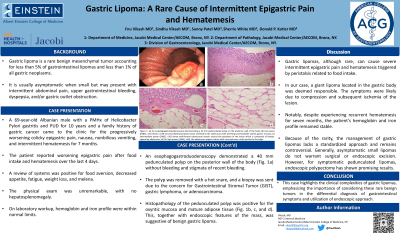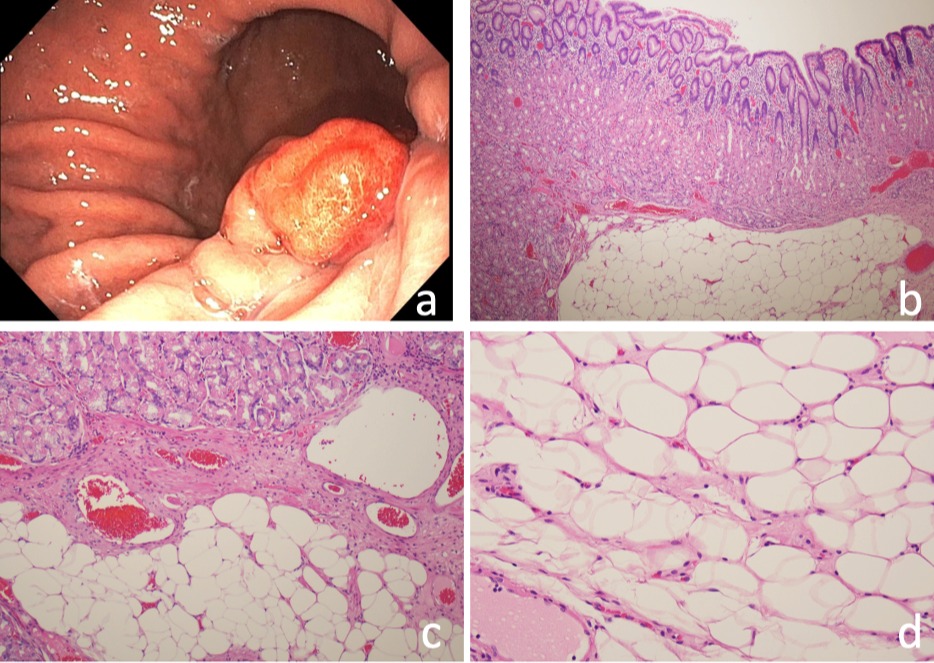Monday Poster Session
Category: GI Bleeding
P2072 - Gastric Lipoma: A Rare Cause of Intermittent Epigastric Pain and Hematemesis
Monday, October 23, 2023
10:30 AM - 4:15 PM PT
Location: Exhibit Hall


Fnu Vikash, MD
Albert Einstein College of Medicine, Jacobi Medical Center
Bronx, NY
Presenting Author(s)
Fnu Vikash, MD1, Sindhu Vikash, MD1, Sunny Patel, MD2, Sherrie White, MD2, Donald Kotler, MD2
1Albert Einstein College of Medicine, Jacobi Medical Center, Bronx, NY; 2Jacobi Medical Center, Albert Einstein College of Medicine, Bronx, NY
Introduction: Gastric lipoma is a rare benign mesenchymal tumor accounting for less than 5% of gastrointestinal lipomas and less than 1% of all gastric neoplasms. It is usually asymptomatic when small but may present with intermittent abdominal pain, upper gastrointestinal bleeding, dyspepsia, and/or gastric outlet obstruction.
Case Description/Methods: A 69-year-old Albanian male with a past medical history of Helicobacter pylori gastritis and peptic ulcer disease for 10 years and a family history of gastric cancer came to the clinic for the progressively worsening colicky epigastric pain, nausea, nonbilious vomiting, and intermittent hematemesis for 7 months. The patient reported worsening epigastric pain after food intake and hematemesis over the last 4 days. A review of systems was positive for food aversion, decreased appetite, fatigue, weight loss, and melena. The physical exam was unremarkable, with no hepatosplenomegaly. On laboratory workup, hemoglobin and iron profile were within normal limits. An esophagogastroduodenoscopy demonstrated a 40 mm pedunculated polyp on the posterior wall of the body (Fig. 1a) without bleeding and stigmata of recent bleeding. The polyp was removed with a hot snare, and a biopsy was sent due to the concern for Gastrointestinal Stromal Tumor (GIST), gastric lymphoma, or adenocarcinoma. Histopathology of the pedunculated polyp was positive for the oxyntic mucosa and mature adipose tissue (Fig. 1b, c, and d). This, together with endoscopic features of the mass, was suggestive of benign gastric lipoma.
Discussion: Gastric lipomas, although rare, can cause severe intermittent epigastric pain and hematemesis triggered by peristalsis related to food intake. In our case, a giant lipoma located in the gastric body was deemed responsible. The symptoms were likely due to compression and subsequent ischemia of the lesion. Notably, despite experiencing recurrent hematemesis for seven months, the patient's hemoglobin and iron profile remained stable. Because of the rarity, the management of gastric lipomas lacks a standardized approach and remains controversial. Generally, asymptomatic small lipomas do not warrant surgical or endoscopic excision. However, for symptomatic pedunculated lipomas, endoscopic polypectomy has shown promising results. Conversely, larger broad-based tumors carry a higher risk of endoscopic perforation, necessitating surgical excision in such cases.

Disclosures:
Fnu Vikash, MD1, Sindhu Vikash, MD1, Sunny Patel, MD2, Sherrie White, MD2, Donald Kotler, MD2. P2072 - Gastric Lipoma: A Rare Cause of Intermittent Epigastric Pain and Hematemesis, ACG 2023 Annual Scientific Meeting Abstracts. Vancouver, BC, Canada: American College of Gastroenterology.
1Albert Einstein College of Medicine, Jacobi Medical Center, Bronx, NY; 2Jacobi Medical Center, Albert Einstein College of Medicine, Bronx, NY
Introduction: Gastric lipoma is a rare benign mesenchymal tumor accounting for less than 5% of gastrointestinal lipomas and less than 1% of all gastric neoplasms. It is usually asymptomatic when small but may present with intermittent abdominal pain, upper gastrointestinal bleeding, dyspepsia, and/or gastric outlet obstruction.
Case Description/Methods: A 69-year-old Albanian male with a past medical history of Helicobacter pylori gastritis and peptic ulcer disease for 10 years and a family history of gastric cancer came to the clinic for the progressively worsening colicky epigastric pain, nausea, nonbilious vomiting, and intermittent hematemesis for 7 months. The patient reported worsening epigastric pain after food intake and hematemesis over the last 4 days. A review of systems was positive for food aversion, decreased appetite, fatigue, weight loss, and melena. The physical exam was unremarkable, with no hepatosplenomegaly. On laboratory workup, hemoglobin and iron profile were within normal limits. An esophagogastroduodenoscopy demonstrated a 40 mm pedunculated polyp on the posterior wall of the body (Fig. 1a) without bleeding and stigmata of recent bleeding. The polyp was removed with a hot snare, and a biopsy was sent due to the concern for Gastrointestinal Stromal Tumor (GIST), gastric lymphoma, or adenocarcinoma. Histopathology of the pedunculated polyp was positive for the oxyntic mucosa and mature adipose tissue (Fig. 1b, c, and d). This, together with endoscopic features of the mass, was suggestive of benign gastric lipoma.
Discussion: Gastric lipomas, although rare, can cause severe intermittent epigastric pain and hematemesis triggered by peristalsis related to food intake. In our case, a giant lipoma located in the gastric body was deemed responsible. The symptoms were likely due to compression and subsequent ischemia of the lesion. Notably, despite experiencing recurrent hematemesis for seven months, the patient's hemoglobin and iron profile remained stable. Because of the rarity, the management of gastric lipomas lacks a standardized approach and remains controversial. Generally, asymptomatic small lipomas do not warrant surgical or endoscopic excision. However, for symptomatic pedunculated lipomas, endoscopic polypectomy has shown promising results. Conversely, larger broad-based tumors carry a higher risk of endoscopic perforation, necessitating surgical excision in such cases.

Figure: Figure 1: (a) An esophagogastroduodenoscopy demonstrating a 40 mm pedunculated polyp on the posterior wall of the body; (b) low power ([H&E], ×10) shows a well-circumscribed lipomatous lesion confined to the submucosa with overlying unremarkable oxyntic gastric mucosa; (c) intermediate power ([H&E], ×20) shows well-formed submucosal vessels around the periphery of the lesion which is composed of benign-appearing adipocytes; (d) On high power ([H&E], ×40), the adipocytes appear mature with inconspicuous nuclei pushed to the edge.
Disclosures:
Fnu Vikash indicated no relevant financial relationships.
Sindhu Vikash indicated no relevant financial relationships.
Sunny Patel indicated no relevant financial relationships.
Sherrie White indicated no relevant financial relationships.
Donald Kotler indicated no relevant financial relationships.
Fnu Vikash, MD1, Sindhu Vikash, MD1, Sunny Patel, MD2, Sherrie White, MD2, Donald Kotler, MD2. P2072 - Gastric Lipoma: A Rare Cause of Intermittent Epigastric Pain and Hematemesis, ACG 2023 Annual Scientific Meeting Abstracts. Vancouver, BC, Canada: American College of Gastroenterology.
